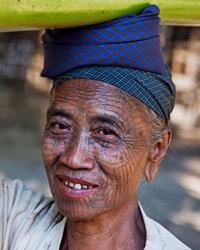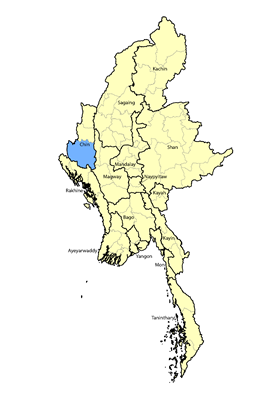Although the Ethnologue lists "Hettui" as one of four dialects of the Songlai language, linguists say that Hiatuii should now be considered a distinct people group and language. The Hiatuii largely keep to themselves. One historical source said: “Marrying people from other tribes is uncommon, “and it is unheard of to marry other races, foreigners, or slaves. Illegal cohabitation would be such a disgrace to a family that they would be cast out from their community. It is paramount to keep clan or family pure. Once married to a different tribe, descendants can never become pure again.”
Location: With a small population of 2,000 people, the Hiatuii are a newly documented tribe in western Myanmar. They inhabit ten villages in two non-contiguous areas in the mountains of Paletwa Township, between the Lemro and Tin rivers.1 The densely-forested area sits in the southernmost tip of Chin State. The Hiatuii territory is bordered by people from the Songlai, Uppu, and Daai Chin tribes. Although their communities are located near the border with Rakhine State, it is unclear if any Hiatuii people live in Rakhine.
Language: Although almost nothing is known of the Hiatuii language, a visitor to the Hiatuii observed: “With their small numbers, the Hiatuii are having difficulty registering their language as an official language of Myanmar but have created some educational resources to make sure it can be passed on to the younger generation.”
The Hiatuii live near the Lemro River, which flows through the southern Chin Hills into Rakhine State before it empties into the Bay of Bengal east of Sittwe. The river was named after the four kingdom cities established along its banks by the Rakhine people between the 8th and 13th centuries. “Le” refers to “four” and “mro” means “cities.”
The Hiatuii are one of several Chin tribes in southern Chin State who tattooed the faces of their girls. While other groups did it when the girls reached puberty, “the Hiatuii are unique among the many tattoo-faced Chin peoples in that they tattooed their girls very young. All recall being between five and ten years old when their tattoo was made…. For the last generation of ladies, the tool used was shaped much like a chisel and had several steel needles attached. This, along with the small faces of young girls, allowed up to five or six girls to get their tattoo every day by one tattooist.”
Most Hiatuii people today observe the animistic beliefs and rituals practiced by their forefathers, with two spirits known as Mati and Matu prominent among the deities they have worshipped for countless generations. Some Hiatuii families have outwardly converted to Buddhism, which was introduced to them by the Rakhine and other groups in the area. Others have adopted Christianity, but spirit-appeasement remains at the core of their society. The Hiatuii also believed that “having a small tattoo on your hand or arm is required during life and is given as payment to the gatekeeper for admission to the afterlife.”
In 1929, the Bible Churchmen's Missionary Society sent H. Hacking and his wife, accompanied by nine Mizo evangelists, up the Lemro River from their base in Sittwe, Rakhine State. They searched for opportunities among the unreached tribes in the hills and went as far as Paletwa in Chin State, where the Hiatuii people live. Alas, it seems their main targets were Khumi and Mro-Khimi people, among whom they baptized small pockets of converts. There is no record of the Hiatuii ever being targeted with the Gospel. Today, it is thought that only a few hundred professing Christians exist among this unique tribe. The Gospel has not penetrated the Hiatuii as it has many other Chin tribes further north. Work to translate the New testament into Hiatuii has been underway for years and is expected to be completed in 2027 or 2028.
Scripture Prayers for the Hiatuii in Myanmar (Burma).
| Profile Source: Asia Harvest |











